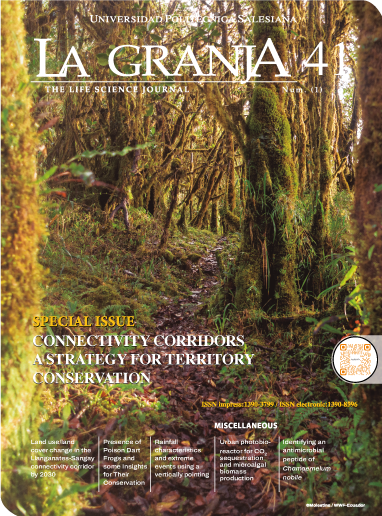Multivariate analysis of Ecuadorian provinces and protected areas based on the presence of poison dart frogs (Dendrobatidae) and some insights for their conservation
Main Article Content
Abstract
Article Details

This work is licensed under a Creative Commons Attribution-NonCommercial-ShareAlike 4.0 International License.
Universidad Politécnica Salesiana of Ecuador preserves the copyrights of the published works and will favor the reuse of the works. The works are published in the electronic edition of the journal under a Creative Commons Attribution/Noncommercial-No Derivative Works 3.0 Ecuador license: works can be copied, used, disseminated, transmitted and publicly displayed.
The undersigned author partially transfers the copyrights of this work to Universidad Politécnica Salesiana of Ecuador for the printed edition.
References
Abdi, H. and Williams, L. (2010). Principal component analysis. Wiley interdisciplinary reviews: computational statistics, 2(4):433–459. Online: https://n9.cl/j3ur5.
Amphibiaweb (2022). A specimen of Epipedobates machalilla (Dendrobatidae). Amphibiaweb. Online: https://bit.ly/4ht2zG8.
Centro Jambatu de Investigación y Conservación de Anfibios (2024). Tres nuevas especies de ranas se suman a la riqueza de anfibios que hay en Ecuador. Anfibios Ecuador. Online: https://anfibiosecuador.ec/.
Clarke, K., Somerfield, P., and Gorley, R. (2016). Clustering in non-parametric multivariate analyses. Journal of Experimental Marine Biology and Ecology, 483:147–155. Online: https://n9.cl/7kqch.
Crespo, S., Solórzano, C., and Guerrero, J. (2022). Tráfico nacional de fauna silvestre y especies amenazadas: Un estudio descriptivo en Manabí (Ecuador). LA GRANJA. Revista de Ciencias de la Vida, 35(1):33–44. Online: https://n9.cl/p3gmx.
Daly, J., McNeal, E., Overman, L., and Ellison,D. (1985). A new class of cardiotonic agents: structure-activity correlations for natural and synthetic analogs of the alkaloid pumiliotoxin b (8-hydroxy-8-methyl-6-alkylidene-1-azabicyclo [4.3. 0] nonanes). Journal of medicinal chemistry, 28(4):482–486. Online: https://n9.cl/0i5l0.
Daly, J., Spande, T., and Garraffo, H. (2005). Alkaloids from amphibian skin: a tabulation of over eight-hundred compounds. Journal of natural products, 68(10):1556–1575. Online: https://n9.cl/2nbub.
Delgado, E., León, M., Cantos, C., and Guzmán, M. (2023). Efecto de la actividad minera sobre la biodiversidad en un sector del cantón Paquisha, provincia de Zamora Chinchipe-Ecuador. La Granja, 38(2):104–121. Online: https://n9.cl/51xta.
Gallice, G. (2009). A specimen of ameerega bilinguis (Dendrobatidae) in Coca, Orellana. Wikimedia Commons. Online: https://shorturl.at/Xdg9v.
Gómez, M. andd Ortega-Andrade, H. (2017). Biogeography of the Dendrobatidae family in Ecuador: Ecological Niche Models, diversity, endemism and threats. Master’s thesis, Autonomous University of Barcelona.
Greenacre, M., Groenen, P., Hastie, T., d’Enza, A., Markos, A., and Tuzhilina, E. (2022). Principal component analysis. Nature Reviews Methods Primers, 2(1):100. Online: https://n9.cl/g8x5m.
Guisan, A., Tingley, R., Baumgartner, J., Naujokaitis-Lewis, I., Sutcliffe, P., Tulloch, A., Regan, T., Brotons, L., McDonald-Madden, E., and Mantyka-Pringle, C. (2013). Predicting species distributions for conservation decisions. Ecology letters, 16(12):1424–1435. Online: https://n9.cl/i8ae8.
International Union for Conservation of Nature (2009). The IUCN red list of threatened species. IUCN. Online: https://n9.cl/bk3tb.
Jolliffe, I. (2002). Principal Component Analysis. Springer Series in Statistics, 2nd ed edition.
Jolliffe, I. and Cadima, J. (2016). Principal component analysis: a review and recent developments. Philosophical transactions of the royal society A: Mathematical, Physical and Engineering Sciences, 374(2065):20150202. Online: https://n9.cl/6j3ha.
Jongsma, G., Hedley, R., Durães, R., and Karubian, J. (2014). Amphibian diversity and species composition in relation to habitat type and alteration in the mache-chindul reserve, northwest ecuador. Herpetologica, 70(1):34–46. Online: https://n9.cl/ltaoh.
Kassambara, A. (2017). Agglomerative hierarchical clustering. Data Novia. Online: https://shorturl.at/gP2g2.
Klimsa, E. (2020). A specimen of Hyloxalus infraguttatus (Dendrobatidae). iNaturalis. Online: https://shorturl.at/cLTOj.
Legendre, P. and Legendre, L. (2012). Numerical Ecology. Springer Series in Statistics, 3rd ed. edition.
Ministerio del Ambiente, Agua y Transición Ecológica (2023). A specimen of Hyloxalus infraguttatus (Dendrobatidae). Ministerio del Ambiente, Agua y Transición Ecológica. Online: https://n9.cl/1xvp9.
Molina, M., Terneus, E., Yánez, P., and Cueva, M. (2018). Resilience of phytoplankton community in the Andean Papallacta lagoon and its tributaries, eight years after an oil spill. LA GRANJA. Revista de Ciencias de la Vida, 28(2):67–83. Online: https://n9.cl/j79nwd.
Myers, N., Mittermeier, R., Mittermeier, C., Da Fonseca, G., and Kent, J. (2000). Biodiversity hotspots for conservation priorities. Nature, 403(6772):853– 858. Online: https://bit.ly/3CNBAGz.
Ortiz, C., Páez, V., and Zapata, F. (2013). Temperature and precipitation as predictors of species richness in northern Andean amphibians from Colombia. Caldasia, 35(1):65–80. Online: https://n9.cl/ldo52.
Patocka, J., Wulff, K., and Palomeque, M. (1999). Dart poison frogs and their toxins. ASA newsletter, 74:16–18. Online: https://n9.cl/gxsq1.
Pisces Conservation Ltd (2014). Community Analysis Package 4.0. Software.informer. Online: https://n9.cl/s7xvl.
Ron, S. andMerino-Viteri, A. and Ortiz, D. (2024). Anfibios del ecuador. version 2024.0. Museo de Zoología, Pontificia Universidad Católica del Ecuador. Online: https://n9.cl/iwiuj4.
Santos, J. and Cannatella, D. (2011). Phenotypic integration emerges from aposematism and scale in poison frogs. Proceedings of the national academy of sciences, 108(15):6175–6180. Online: https://n9.cl/0h77xr.
Santos, J., Coloma, L., and Cannatella, D. (2003). Multiple, recurring origins of aposematism and diet specialization in poison frogs. Proceedings of the National Academy of Sciences, 100(22):12792– 12797. Online: https://n9.cl/f7isa.
Spande, T., Garraffo, H., Edwards, M., Yeh, H., Pannell, L., and Daly, J. (1992). Epibatidine: a novel (chloropyridyl) azabicycloheptane with potent analgesic activity from an Ecuadoran poison frog. Journal of the American Chemical Society, 114(9):3475–3478. Online: https://n9.cl/dgpmk1.
Tapia, E., Coloma, L., Pazmiño-Otamendi, G., and Peñafiel, N. (2017). Rediscovery of the nearly extinct longnose harlequin frog Atelopus longirostris (Bufonidae) in Junín, Imbabura, Ecuador. Neotropical Biodiversity, 3(1):157–167.
Tubifex (2010). A specimen of Epipedobates anthonyii (Dendrobatidae). Wikimedia Commons. Online: https://n9.cl/63j57.
Valencia, J., Betancourt, R., Yánez, P., Asanza, O., Benalcázar, Y., Hidalgo, J., and Campaña, J. (2009a). Anfibios y Reptiles en ambientes cercanos a Pedro Vicente Maldonado y Balao. Fundación Herpetológica Gustavo Orcés.
Valencia, J., Betancourt, R., Yánez, P., Olmedo, J., and Flores, R. (2009b). Anfibios y Reptiles en ambientes cercanos a Nueva Loja y Lumbaquí. Ecofondo y Fundación Herpetológica Gustavo Orcés.
Vilhena, D. and Antonelli, A. (2015). A network approach for identifying and delimiting biogeographical regions. Nature communications, 6(1):6848. Online: https://n9.cl/yvgyh.
Wold, S., Esbensen, K., and Geladi, P. (1987). Principal component analysis. Chimometrics and intelligent laboratory systems. In Conference on Emerging Technologies Factory Automation Efta, number 2, pages 704–706.
Yánez, P. and, B. J. and Quishpe, C. (2013). Multivariate characterization of the entities that make up the patrimony of natural areas of the Ecuadorian state: Phase i. La Granja: Revista de Ciencias de la Vida, 18(2):5–32. Online: https://n9.cl/xegcev.

